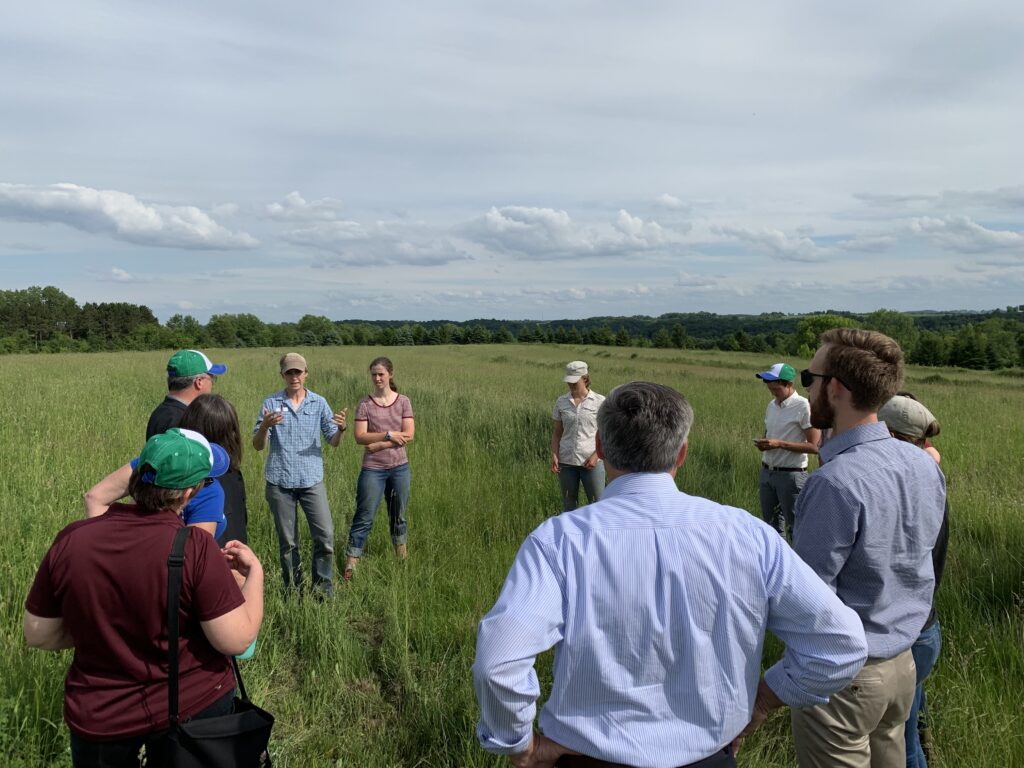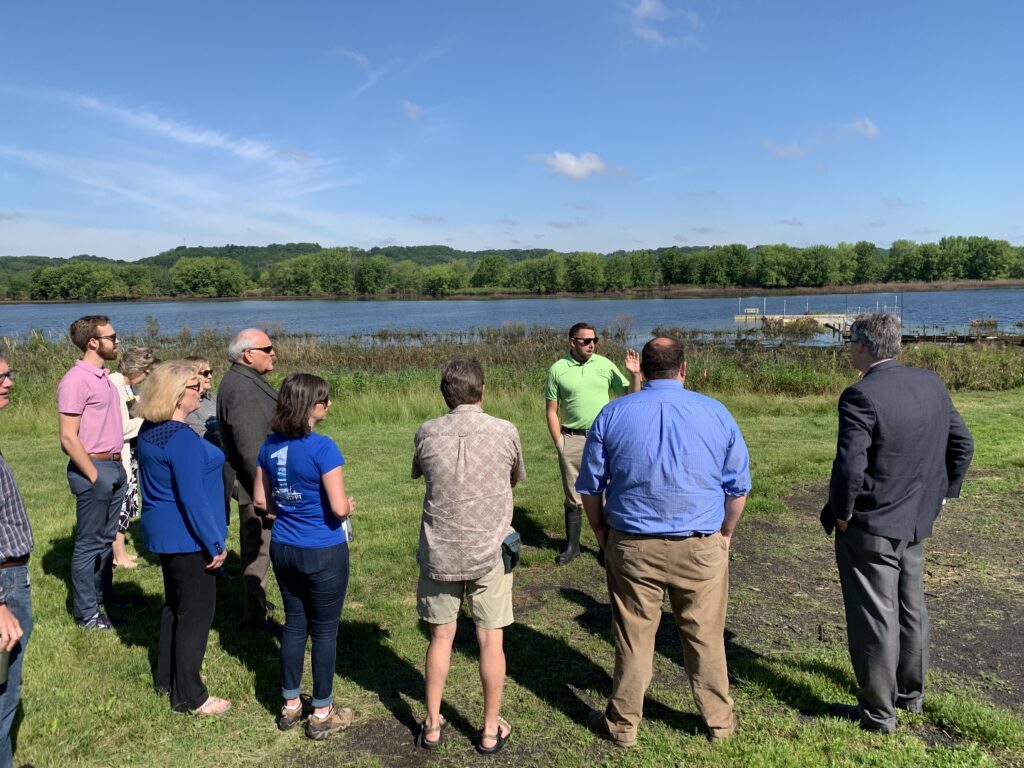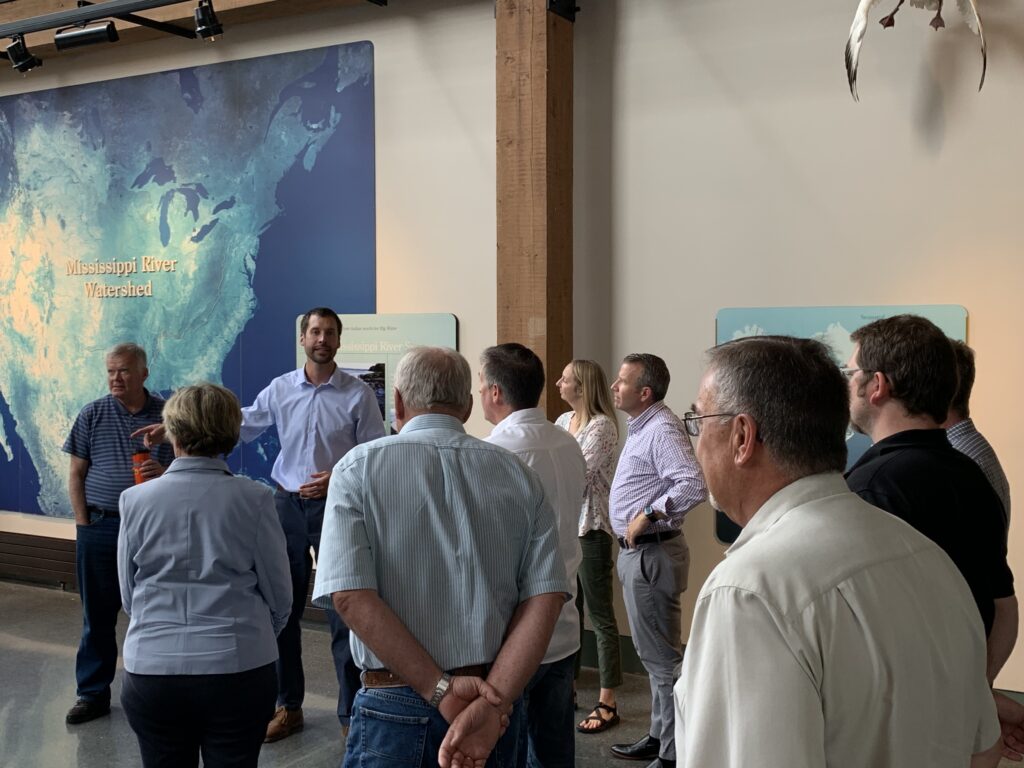
NCEL Events
Lessons from the Great River Road
From Minneapolis to St. Louis, legislators met with local stakeholders on a range of Mississippi River issues
At a time of unprecedented flooding and rapidly changing weather patterns, river communities are coming together to adapt to a new normal.
From June 18 to 21, our team traveled from Minneapolis to St. Louis to meet with state legislators and a host of local officials, organizations, and stakeholders along the way. We organized seven unique events and collectively had conversations with nearly 60 people about nutrient pollution, flood resilience, and the health of the Mississippi River.
Each stop was different, whether it was touring a sustainable farm in Red Wing, Minnesota, or witnessing the ability of Nahant Marsh to mitigate flooding in Davenport, Iowa. Clear themes emerged about improving resilience in the region and ensuring these communities exist for generations to come. Here are some of those takeaways.
Flooding Is Increasing
The recent flooding has broken a host of records. It is the longest-lasting flood since 1927. Many river communities have experienced some of the highest flood levels on record. The Missouri River Basin has taken on more runoff in three months than it typically gets in a year. The impact of all this was clear from closed roads throughout our tour.
Perhaps most importantly, the frequency of flooding is increasing. The last major 200-year flood event happened just eight years ago, in 2011.
Each of these flooding events damages property, endangers human life, and washes a host of nutrients and chemicals into the river. These effects are basin-wide and accumulate throughout the river’s path resulting in a dangerous mix of pollutants impacting Louisiana’s coastline. States and cities are beginning to consider more natural solutions (such as wetlands) as a method of flood protection in order to absorb water and filter out the inputs before they pass into the Mississippi.
Young Farmers are The Future
As the average age of farmers continues to rise, there is a growing recognition of the need to engage young farmers in discussions about sustainability. In many cases, younger farmers are more likely to adopt sustainable practices like cover crops that improve conservation without harming productivity. The National Young Farmers Coalition (NYFC) is one network that helps ensure young farmers are successful through education and engagement.
In Minnesota, NYFC and State Senator Mike Goggin passed a bill, HF 1, that provides an income tax credit for retiring farmers to either sell or rent their land to beginning farmers. This type of program will help engage a new generation of farmers from diverse backgrounds who might otherwise have limited access to land.
Innovative Farming Practices
On our trip, we toured the Lake City Catholic Worker Farm (LCCWF) in southern Minnesota. LCCWF is applying innovative conservation practices to diversify their crops, more effectively retain water, and ensure success. The farm is embracing a set of new opportunities to increase profits at a time where corn and soybeans are being impacted by flooding and tariffs. As a result, they are about to open a kombucha stand and began a Community Supported Agriculture (CSA) program by growing vegetables on the farm.

Also in Minnesota, Green Lands Blue Waters is an organization that supports more perennial plants and continuous cover to reduce nutrient runoff. They are studying innovative options, such as a newer crop called Kernza, that could provide economic opportunity in addition to conservation benefits. Other groups in the region, including the Izaak Walton League of America, are working directly with local farmers on practices that improve soil health and water retention. A collection of state policy options on soil health from IWLA is available here.
Wetlands Are Key
Previously an EPA superfund site, Davenport’s Nahant Marsh now works as a 305-acre sponge ready to absorb excess flood water and filter nutrient runoff like nitrogen and phosphorous. During peak flows, the marsh is estimated to absorb and filter 2 billion gallons of water. But even as the city of Davenport works to expand the wetland area, it is clear that more of these natural solutions are necessary both directly on the river, like Nahant, and throughout the broader watershed.
Davenport has become a case study along the river for its decision to not implement a permanent flood wall, but instead rely on a riverfront park, Nahant Marsh, and other natural solutions.
Wetlands may not be the universal solution for flood protection, however, they are a vital but still underused tool. Efforts to increase wetland ecosystems and nature preserves throughout the Mississippi River Basin would increase resilience while severely decreasing costs in many areas. You can learn more through our flood resilience fact sheet.

Federal Support is Needed
There is only so much that can be done at the state and local level. Ultimately, the rising cost of these disasters mixed with the national importance of the Mississippi River’s agricultural sector requires support from the federal government. This latest flooding event is predicted to cost $2 billion, and is on the heels of another catastrophic flood in 2011.
There are several ways the federal government can help. Congress is currently discussing a resilience revolving loan fund that would provide low-interest funds for cities to proactively prepare for flooding rather than retroactively paying for the cleanup. Increased funding for nutrient reduction programs would help spur recommendations from the Gulf Hypoxia Task Force and reduce the size of the dead zone in the Gulf of Mexico that threatens coastal fisheries. Improved Farm Bill provisions could incentive more sustainable agricultural practices in a way that protects productivity while decreasing runoff.
These discussions are underway and state legislators in the region have joined mayors in the Mississippi River Cities and Towns Initiative along with River Citizens in the Mississippi River Network to collectively work with Congress on innovative solutions and funding mechanisms.
Increasing Collaboration
The most consistent theme in every meeting was that of collaboration. There is one river that connects the agricultural economies throughout the 10-state corridor, provides drinking water for more than 20 million people, and serves as habitat for some of America’s greatest species.
Throughout these meetings, legislators, mayors, state agency officials, and others came together to discuss successes and opportunities. They also discussed new partnerships and sought to identify those who were not yet part of the conversation. In Dubuque, attendees met at the National Mississippi River Museum and Aquarium and hope to see more involvement from educational institutions up and down the river. Other allies, like casinos, were discussed as potential partners who are eager to invest locally to ensure the community succeeds.

No single level of government can protect the river alone. Preserving the way of life in the Mississippi River region will take an unprecedented level of collaboration between cities, states, and the federal government. Cities will need to share adaptation successes with their neighbors and states will need to increase support for efforts that prevent an influx of nutrients into the river.
Changes in flood frequency and temperature may have become the new normal, but a host of innovative solutions ranging from redeveloped wetland areas to commercialized cover crops show that adaptation is both possible and achievable.